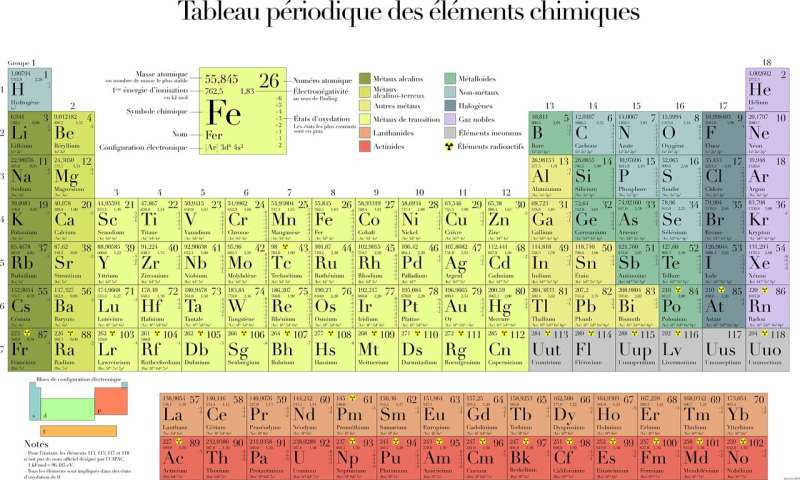Periodic table discovered at St. Andrews recognized as oldest in the world

A periodic table chart discovered at the University of St Andrews is officially recognised as the oldest in the world by the Guinness World Records.
The chart of elements, dating from 1885, was discovered in the University's School of Chemistry by Dr. Alan Aitken during a clear out. Now, following international media coverage of the find, the periodic table chart has been officially certified as the world's oldest by the Guinness World Records.
Following the discovery in 2014, the periodic table chart was subsequently sent for authentication and to be preserved for future generations. Marking the International Year of the periodic table, the fully restored chart was unveiled at a special event at the European Parliament to celebrate 150 years of the periodic table in January 2019, hosted by former St Andrews Rector, Catherine Stihler MEP.
Mendeleev made his famous disclosure on periodicity in 1869; the newly unearthed table was rather similar, but not identical to Mendeleev's second table of 1871. The table is annotated in German, and an inscription at the bottom left, 'Verlag v. Lenoir & Forster, Wien', which identifies a scientific printer who operated in Vienna between 1875 and 1888. Another inscription, 'Lith. von Ant. Hartinger & Sohn, Wien', identifies the chart's lithographer, who died in 1890. Working with the University's Special Collections team, the University sought advice from a series of international experts to accurately date the chart. Following further investigations, no earlier lecture chart of the table appears to exist. Professor Eric Scerri, an expert on the history of the periodic table from the University of California, Los Angeles (UCLA), dated the table to between 1879 and 1886 based on the represented elements. For example, both gallium and scandium, discovered in 1875 and 1879 respectively, are present, while germanium, discovered in 1886, is not.
The University's Special Collections team was awarded a funding grant from the National Manuscripts Conservation Trust (NMCT) for the conservation of the chart in collaboration with private conservator Richard Hawkes (Artworks Conservation). The funding also allowed production of a full-size facsimile which is now on display in the School of Chemistry. The original periodic table has been rehoused in conservation grade material and is held in Special Collections' climate-controlled stores in the University.
Professor David O'Hagan, recent ex-Head of Chemistry at the University of St Andrews, said: "When I took over as Head of Chemistry in 2014 I was asked by the University to clear a large storage area under a lecture theatre. It was densely packed with chemicals and laboratory equipment left by professors who had retired over the years. Alan's eye was caught by a bundle of old rolled up teaching charts which were buried deep and he was astute enough to notice this periodic table which was battered and worn. It was clearly an early example and we had it assessed by experts. It emerged to be unique, the earliest example of a display Table. It was a wonderful find which has caught the attention of science enthusiasts around the world.''
Gabriel Sewell, Head of Special Collections, University of St Andrews, added: "We are delighted that we now know when the oldest known periodic table chart came to St Andrews to be used in teaching. To be officially recognised by the Guinness World Records is a wonderful achievement. Thanks to the generosity of the National Manuscripts Conservation Trust, the table has been preserved for current and future generations to enjoy and we look forward to making it accessible to all."
The Periodic Table and Us: Its History, Meaning and Element Scarcity, hosted by former University of St Andrews Rector Catherine Stihler MEP took place at the European Parliament in January 2019. The event also unveiled a new periodic table showing the scarcity of elements used in everyday devices.
Provided by University of St Andrews




















